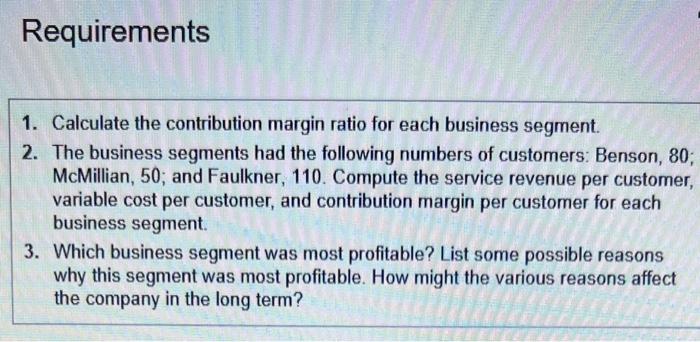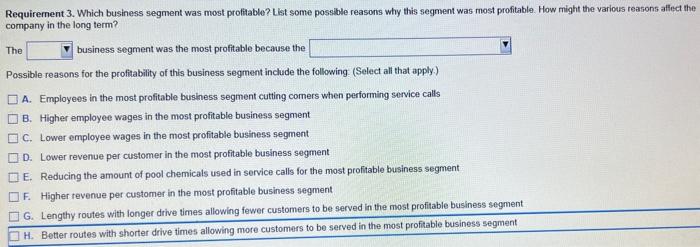2. dont understand

Requirements 1. Calculate the contribution margin ratio for each business segment. 2. The business segments had the following numbers of customers: Benson, 80; McMillian, 50; and Faulkner, 110. Compute the service revenue per customer, variable cost per customer, and contribution margin per customer for each business segment. 3. Which business segment was most profitable? List some possible reasons why this segment was most profitable. How might the various reasons affect the company in the long term? Data table Requirement 1. Calculate the contribution margin ratio for each business seoment. Requirement 3. Which business segment was most profitable? Llst some posslble reasons why this segment was most profitable. How might the various reasons allect the company in the long term? The business segment was the most profitable because the Possible reasons for the profitiability of this business segment include the following (Select all that apply.) A. Employees in the most profitable business segment cutting comers when performing service calls B. Higher employee wages in the most profitable business segment C. Lower employee wages in the most profitable business segment D. Lower revenue per customer in the most profitable business segment E. Reducing the amount of pool chemicals used in service calls for the most profitable business segment F. Higher revenue per customer in the most profitable business segment G. Lengthy routes with longer dive times allowing fewer customers to be served in the most profitable business segment H. Better routes with shorter drive times allowing more customers to be served in the most profitable business segment. The possible side effects of the items identified in the preceding step could be (Select all that apply.) A. less fuel and maintenance costs because of efficient routes. B. highly compensated employees resulting in an increase in contribution margin. C. dissatisfied customers because of inadequate service. D. increased service costs because of reduced pool chemical usage causing poor water quality and additional service calls. E. increased customer base due to competitive service prices. F. increased employee turnover because of low wages. G. less fuel and maintenance costs because of lengthier routes












